Watches Prices Are Insane
A survival guide for collecting watches when watch prices don’t make sense.
The New York auctions continue over the next few days. There’s a fun collection of limited-edition IWC Mark XIIs in Christie’s online sale (ending June 11), all from the same collector, so I asked specialist Henry Ishikawa for some photos:
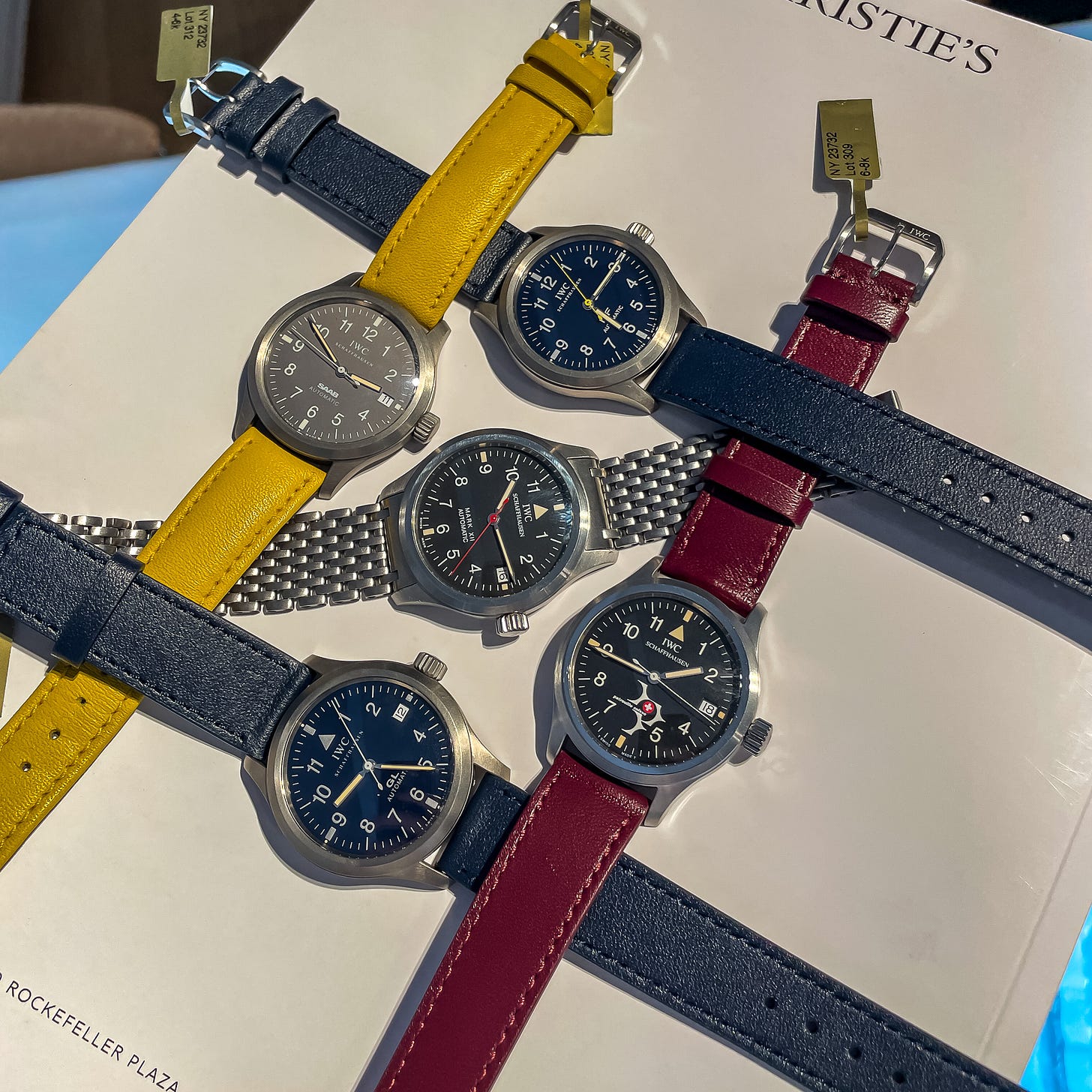
So much of the appeal of the IWC Mark XII is in that beads-of-rice bracelet, so the LE with a red seconds hand (for a Danish finance magazine) might be my pick. But that limited edition for the Patrouille Suisse (the Swiss Air Force's acrobatic pilot team) is also sweet.
In today’s newsletter: My favorite $500 watch gets a refresh, and a Watch of the Week that’ll have you waking up like a real Rolling Stone.
But first, today’s main event—
Watch Prices Are Insane!
I dropped a query on Instagram the other day: What are your watch pet peeves—about brands, media, the actual watches?
You all had thoughts. 200+ responses, which I’ll summarize in a newsletter soon.
But, the biggest complaint: Prices. As in, why are they so d*mn high?
This newsletter has briefly addressed high prices; I also covered it for the Mothership back in 2023, when the answer was still high demand and backlogged supply chains. We’ve also seen the general “premiumization” of watches—that’s more gold Rolex, or brands from Tudor to Grand Seiko slowly raising prices.
Just last week Urban Jürgensen relaunched with prices ranging from $125k to $450k. Last month, Breguet released a one-hander for $48,700. A week later, it raised the price 10 percent to $53,600.
Urban Jürgensen’s watches show impressive artisanal watchmaking, and miniaturizing the cage-mounted remontoir from the Oval Pocket Watch into a wristwatch is truly impressive. But as SJX wrote:
“Even if the pricing is justified, it isn’t the strong value proposition that an emerging independent brand should be.”
I wrote in January:
The problem isn't just rising prices, but that customers no longer see the value of luxury watches. If a brand increased prices by 10 percent and we felt its watches were 10 percent better, we’d be more or less fine with that. Instead, manufacturers have increasingly automated or industrialized the human touch out of their watches.
Unpolished is about watches with longevity—of both style and quality. Many vintage watches—from Rolex to Seiko to (yes) TAG Heuer—already have proven longevity. They were built to last. To break, be repaired, and run for another quarter century.
Similarly, there’s a recognition that building a beautiful, enduring watch today is just as profound, if not more, in a world of planned obsolescence and a culture that moves at the speed of a scroll. Enduring objects matter more than ever, and watches are worth preserving for their craft and cultural significance.
This can come from large manufacturers or, increasingly, small independents. Large brands must deliver their economies of scale as value to consumers. Whether the brand is small or large, the watches made by man or machine, there has to be a focus on craft and an investment in designers, watchmakers, and engineers who are empowered to make good sh*t.
At the same time, there are not enough watchmakers. You don’t have to be Tyler Cowen to know this means prices will go up. And excellent, talented watchmakers deserve to get theirs.
But the trade-off has broken. Too often, large brands especially cut corners or have McKinsey-ed away craft into efficiency-induced oblivion.
According to Business of Fashion, price increases accounted for 80 percent of the growth in the luxury industry over the last five years. Let’s assume the luxury watch industry was about the same.
We can agree: Watch prices are insane right now.
How To Collect Watches When Watch Prices Are Ridiculous
It’s true at big brands, small independents, and everywhere in between.
And it doesn’t seem to be changing anytime soon. I strongly support buying pre-owned or vintage, and while there are still deals to be had there (it’s the best “buyer’s market” in years!), we’re also not going back to the days when a Paul Newman Daytona was under $100k or a Chronometre Bleu sold at a discount.
So, what’s a collector to do?
Prices are high, but collecting meaningfully isn’t about price—it’s about taste, perspective, and real-world experience.
Relatedly, another subscriber (and watchmaker) shared his pet peeve:
“People talking about the quality of a product without knowing what actually makes it high quality.”
I would never comment on what people do or don’t know—not my place!—but it raises a larger point. There’s only one way to understand what truly matters to you:
Get out there and touch grass. Wind crowns, engage pushers, loupe a movement (all after asking the owner).
Watches are made of atoms. Not pixels on a screen. They’re best experienced in the real world, not in comments arguing about tenths of a millimeter. You have to feel them, touch them, try them on, even when boutiques make it hard.
It’s out of touch to say, go try on a Royal Oak.
But find the “bad” watches too. Visit the pre-owned dealer that “never has anything good” and understand what that means. Notice the hands, how the bracelet articulates, brushing, finishing, and tolerances that do (or don’t) separate that Royal Oak from a Tissot PRX or IWC Ingenieur. Decide what matters to you, given price.
Recently, I visited Mark Cho at the Armoury. I handed him the [REDACTED] watch I was wearing and saw him do exactly this. He held it up to eye level and examined it with the care of picking an avocado at the grocery store. Then, he made a nuanced observation about the integration of the lugs and case— something I’d never noticed about my watch.
I watched him develop his taste in real time. What did he like (and not)? How might this be generalized to other, similar watches? What was notable about its condition?
Over the years, I’ve traveled to auctions, trade shows, and get-togethers—money that could’ve been spent on more watches. But it was better spent on experiencing than acquiring. Seeing watches, meeting dealers and collectors.
There’s no substitute for owning, and eventually, you have to have skin in the game. But quality and condition are the most important traits to understand in watches. They’re mostly discussed in the abstract, but best understood in the details.
You have to experience a wide variety of watches in person to understand what they mean to you. What’s worth paying for, and—importantly—what’s not?
Understand What Matters (To You)
Give yourself enough opportunities to experience real watches in real life, and you’ll start to develop your taste.
But the underlying reality remains: Watches are expensive.
A quick anecdote.
A few years ago, I ran into a collector and subscriber at Windup Watch Fair in New York. Scroll through his Instagram and you’d see vintage grails like a Paul Newman Daytona, Heuer Seafarer, or a Cartier London Tank.
At Windup, I watched him methodically survey affordable microbrands with the same consideration you would’ve thought reserved for a six-figure vintage Rolex before plopping down 800 bucks for the then-new Citizen Mechanical Diver 200M—a cool, modern take on a ‘70s Citizen diver in titanium. To be able to take in hundreds of watches and identify the one that works for you takes a certain amount of experience, taste, and confidence. He’s also not a big dive watch guy, so a Citizen is good enough.
Now, having that Citizen diver in the same collection as a Paul Newman or Heuer Seafarer immediately elevates it.
It also works the other way.
Maybe you’ve got mostly “affordable” watches, but have room for one super luxe watch—whatever that means. Thinking about the coherence of how that single hero piece comes together with everything else in your collection can make it all greater than the sum of its parts.
It’s the classic cool of mixing high and low, but something more. A sense of how a collection of watches can express what you value.
Collect-by-numbers is mind-numbingly dull. Buying a Submariner, then a Speedmaster, then a Reverso because you’ve been told these are the icons you should own. Saying that “every collector needs a Speedmaster”?
Absurd.
It’s the type of big-game hunting we sometimes see from the unfathomably rich. When someone says the theme running through their collecting is “a mission to own the best in each category”—that’s unimaginative.
After all, it’s the constraints, the can’t-have-it-all nature of collecting that makes it fun.
That’s why it’s so thoroughly blah to see Zuck show up with a Greubel Forsey Handmade 1 this week and a Journe Centigraphe the next.
The Path Less Chosen

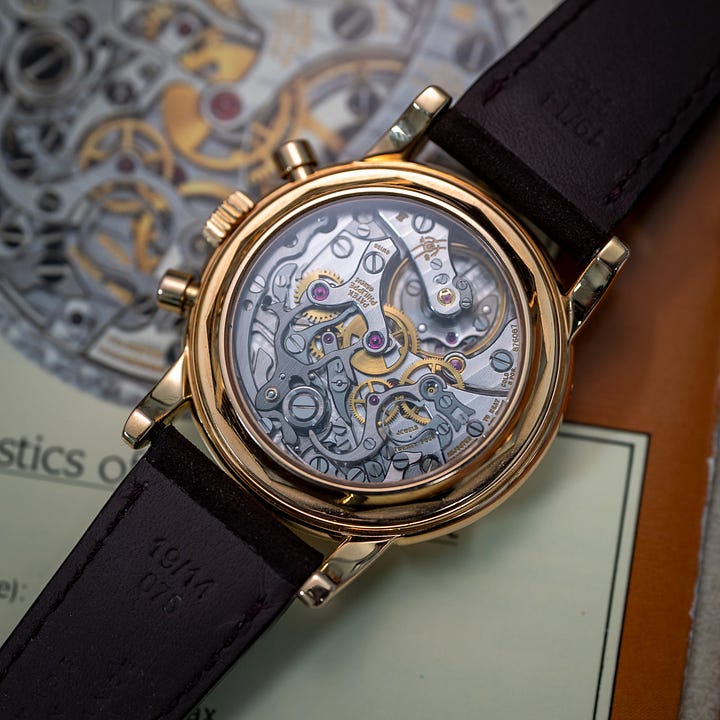
There are other fun ways to collect when watches are expensive and you don’t have money like Zuck:
Break it down to first principles. Maybe you’re inspired by Rexhepi, or Brette, or a Patek Philippe 1518. But what is it, specifically, that you like about those watches? Be able to articulate this to yourself. Certain qualities, features, a philosophy? Then, think about where else that might be found. Maybe it’s Brette’s approach to elevating dialmakers and artisans that can be found in other projects.
Learn about suppliers. In vintage watches, learn about important case, movement, and dial makers. Seek out the suppliers who made components for Patek Philippe, but would also supply Doxa or Mido. Borgel or Favre & Perret cases. Singer and Stern dials. Manufacturers that specialized in making their own, high-quality movements. It’s equally helpful to understand the network of modern suppliers. For example, Le Cercle des Horlogers doesn’t only work with Berneron and Biver.
“One of our tasks is to better understand the structure of the Swiss watchmaking industry,” said Sebastian Vivas, Audemars Piguet’s Heritage Director, when I interviewed him last year. When I asked if there might come a day when, say, Stern dials were as collected as Patek Philippe watches, he said, “I hope that day comes.” In some corners, it’s already here.
Collect history. I enjoy hunting old auction catalogs. Thematic catalogs for brands you admire, such as the 150th Anniversary Art of Patek Philippe (1989) or Magical Art of Cartier (1996), both by Antiquorum, are great places to start.
Pocket watches. Every watchmaker is inspired by pocket watches. High quality, and the size lends itself to interesting designs and movements. When I visited Xhevdet Rexhepi he pulled out an Ebel pocket watch that inspired the case of his Minute Inerte. Surely it can do the same for you.
Straps are a craft too. Finding an artisan that makes cool or custom straps is also a ton of fun. Not only does it elevate your watch, it exercises many of the same muscles as watch collecting, and can similarly support artisans doing great work.
You can’t have it all. Finally, a simple reminder that you don’t need that many watches. So much of “collecting” is focused on acquiring, but most of it is actually waiting and not buying. Identify the watches you can’t compromise on, and patiently wait for the right one. When is the Citizen diver good enough, and when do you go all-out for the Lange Pour Le Mérite?
In the meantime, there are tons of brands with an enduring quality, vintage and modern, that are fun to hunt while you’re searching for those more expensive hero watches. At the extreme, I love vintage Swatch. I’ll drop a few more favorites in the comments.
The best way to collect within constraints is to learn as much as you can about how well-made watches are actually made. That means touching, examining, trying them on, speaking with collectors and watchmakers. This helps develop your taste, to understand what’s worth it to you, and what’s not.
Knowledge is still free, and the best collectors invest their time, curiosity, and attention just as carefully as their money.
For paid subscribers who couldn’t join last week’s livestream, here’s the recording. If you open this link, you can also follow the feed on your podcast app (but don’t call it a podcast!):
Watch of the Week: (Waking Up) Like A Rolling Stone
A lot of cool clocks have been sent my way since I wrote you should “stop waking up to your iPhone alarm.” Here’s one favorite:
Documentary filmmaker Gary Hustwit sent this to me. It came from the archive of Bill Wyman, who was the bass player for the Rolling Stones for 30+ years. It’s a classic Braun alarm clock radio, with a Rolling Stones tour decal dating it to the band’s summer 1982 tour throughout Europe.
"It’s fun to think of Mick [Jagger] or Keith [Richards] waking up to this alarm clock after a late night of partying,” Hustwit texted me. Wyman was always the band’s archivist, and in 2020, he held a charity auction for many of the items he’d compiled over the years. That’s where Hustwit picked up this alarm clock.
Speaking of, the same celebrity-focused auction house is currently holding an auction of late director David Lynch’s property until June 18. One lot has a collection of jewelry and watches, including a modern Longines and a vintage Phinney-Walker pocket alarm clock. Bidding currently at $8,000.
My favorite $500 watch.

One of the watches I wear most is my Merci LMM-01 for Hodinkee. Merci is a retailer in Paris that makes lifestyle items and objects, and happens to make a solid time-only watch.
Merci Instruments added four dials to its LMM-01 collection: Dress, Numerals, Scientific, and Military. The black “Dress” is my favorite—the case works better slightly dressed up. The LMM-01 has slightly downturned and drilled lugs, measuring 38mm x 9.8mm. It’s got a relatively long 47mm lug-to-lug, and the brushed case has a small stepped, polished bezel (Price: $450–$500 on Merci’s site).
Whenever someone picks mine up, they comment on its winding feel, which is pretty tactile for a standard, hand-wound Sellita movement. For $500, there aren’t many watches I recommend before the Merci Instruments LMM-01.

That’s all for this week. Get in touch:
tony@unpolishedwatches.com (don’t reply to this email, they often get lost)
DM on Instagram
My favorite, leave a comment or like this newsletter:



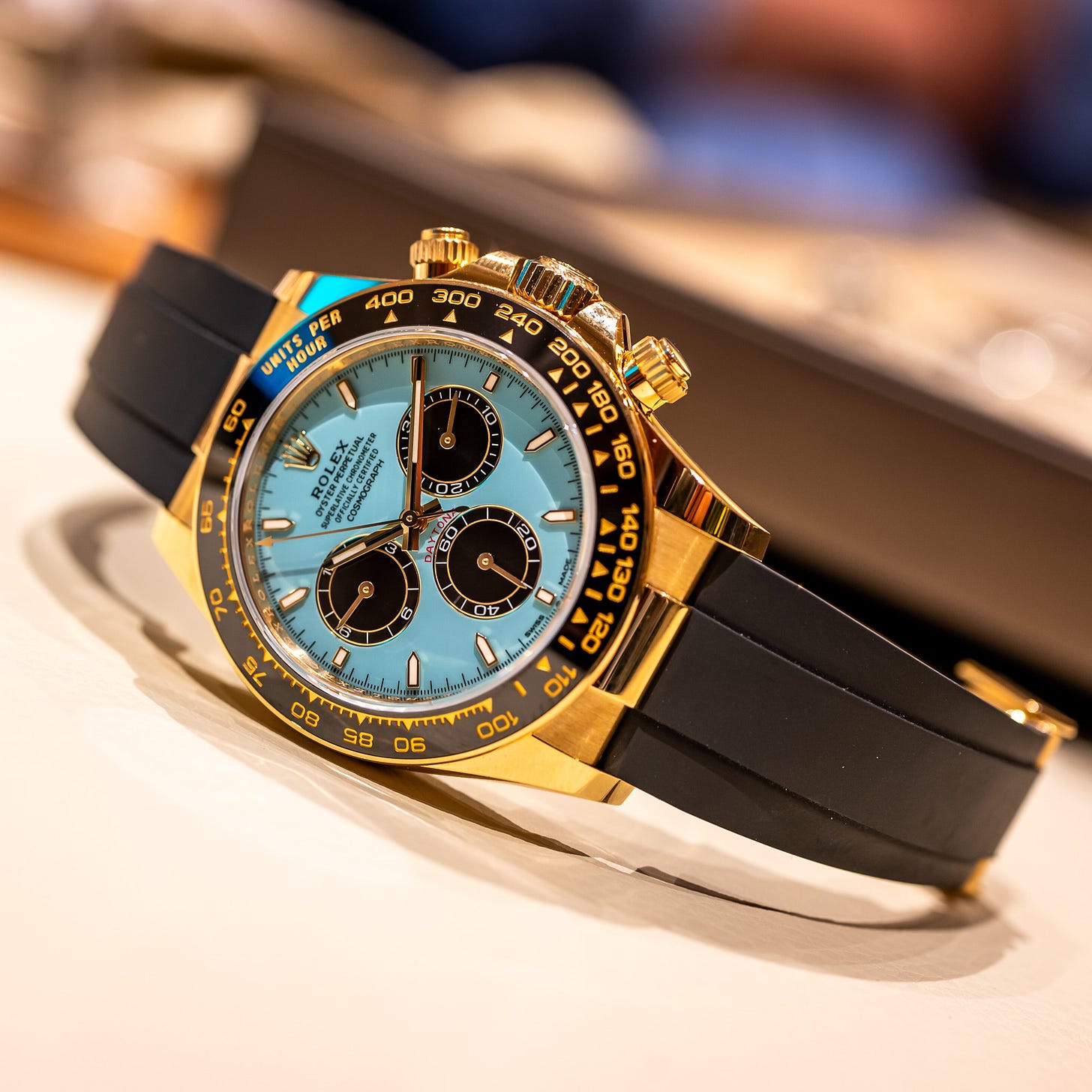

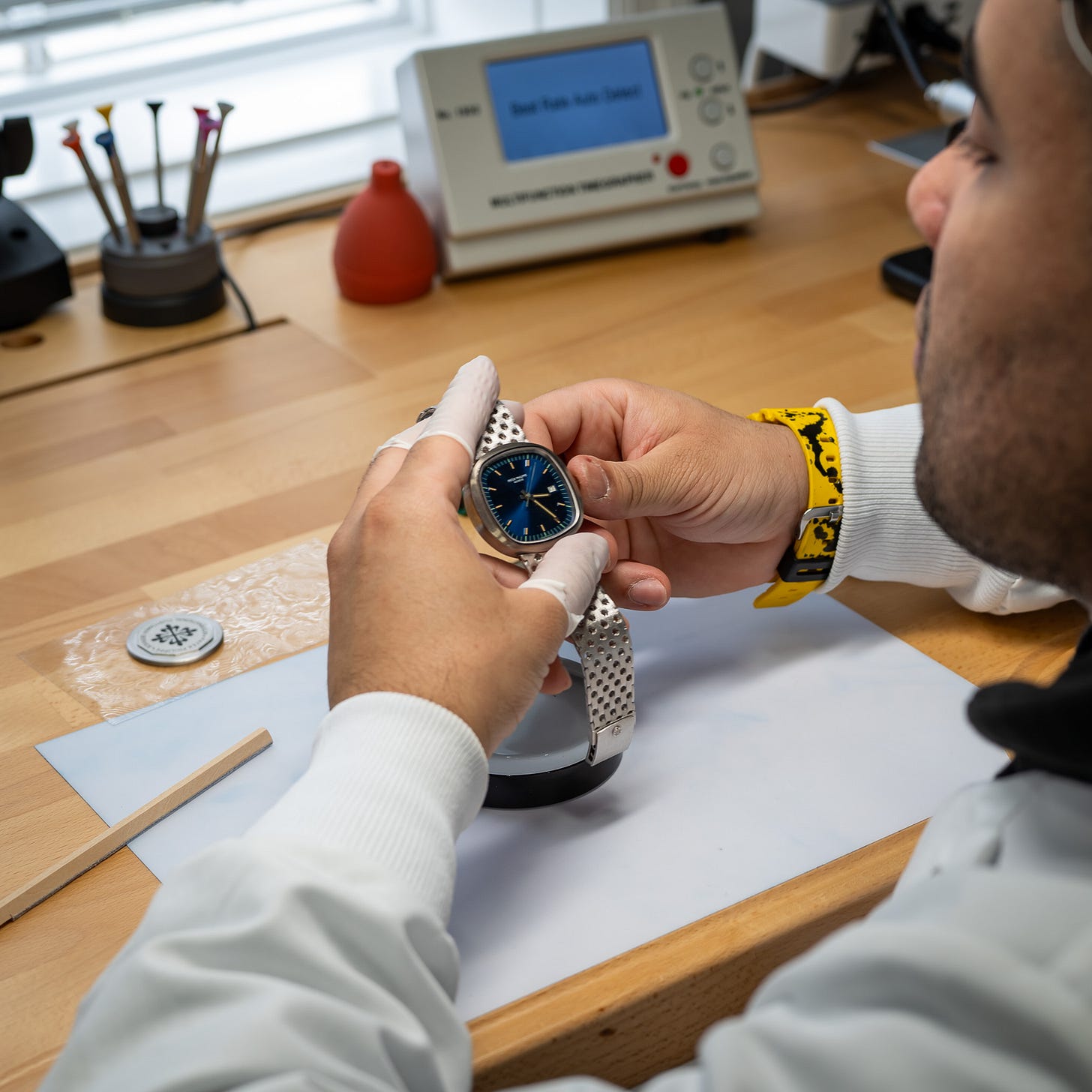

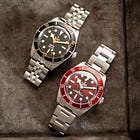


-Large brands that seem on the right side of the fence in investing in product vs. marketing: Nomos, Rolex, Longines, Tudor, Chopard L.U.C. (Lange, but recent price increases are tough)
-Small modern brands that, while they outsource much or all of their production, have considered design and seem to invest in products with enduring quality: Unimatic, Merci, AnOrdain, Furlan Marri, Marin Instruments, Lorca.
-Affordable vintage brands (beyond the obvious) that I'm always hunting: (TAG) Heuer, Eterna, Mido, Movado, Wittnauer, "poor man's" Heuers, LeCoultre, Gallet, military watches from Hamilton, Benrus, and others, old house brands for retailers like Le Gant or Tradition (Sears). So many more!
-Straps: Also, find a craftperson making cool or custom straps. It's a great way to exercise many of same the muscles as in watch collecting, without the bill.
*None of these lists are near exhaustive, simply examples, seeds of an idea!
yes prices are mostly insane, with 99% of the new product on sale, you just don’t get what you paid for.
the solution is simple, stop buying 99% of the new product on sale. hold on to your money till the prices come down.
consumers have all the agency, this is just a hobby for us. if we go a year without buying a single watch, our lives will still go on as normal. but if no one buys a watch for a year, the industry will not survive. that gives us all the power, they work for us, if we let them.
all we have to do now is play hard to get, and watch them trip over their own feet trying to woo us.